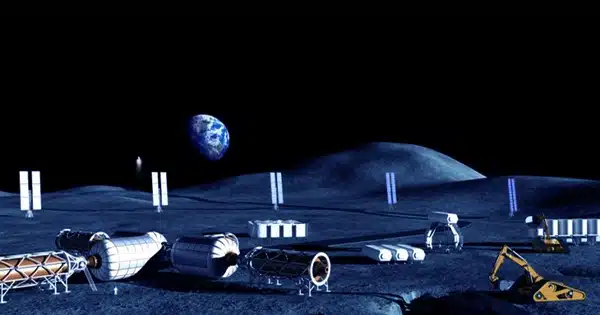“Moonies” would work at terminals encircled by banks of computers or bounce across the surface in Moon jeeps on their way to the Moon mines, which were located inside enormous spheres linked by pressurized subterranean tunnels.
But since the last astronaut made his last step on the Moon in 1972, there are only a few flags, three rovers, a dozen cameras, and 96 bags of human excrement remaining as proof that humans once lived there. (you can read more facts on Apollo here). Where is the Moon outpost that we were promised?
Nujoud Merancy, Nasa’s strategy and architecture head for the exploration systems development mission directorate architecture development office, states that one of the main objectives of what we’re doing today is to ensure that this doesn’t result in flags and footprints and then it gets scrapped again. In non-Nasa jargon, that means Merancy is one of the main figures in charge of organizing the organization’s trip back to the Moon.
She says, “We don’t want to spend another 50 years not exploring beyond low Earth orbit like we have for the last 50 years. We want to lay the groundwork so that this can be an inevitable process that goes forward.”

And so far, the strategy is succeeding. After nearly four weeks in orbit, NASA’s first unmanned Artemis mission returned to Earth in December 2022. It demonstrated the powers of the Orion spacecraft, its European Space Agency (ESA) Service Module, and the massive SLS rocket that propelled it into space. It traveled far beyond the Moon.
The first humans are scheduled to travel to lunar orbit on Artemis II in 2024, and two astronauts will arrive near the lunar south pole on Artemis III sometime in the middle of the decade. There will be at least one female among them.
The final Apollo mission’s Gene Cernan and Harrison Schmitt team spent a total of 75 hours on the lunar surface, making them the longest-staying men to date. They ate and slept in hammocks inside the small rover, and when they wanted to go outside, they slipped on their spacesuits, similar to a camping trip, according to Cernan. In contrast, the Artemis III passengers will spend about a week on the moon and can look forward to a few more home amenities as well as a lot more room. Elon Musk’s SpaceX is providing the spacecraft they will use, and it is based on his Starship design, which was initially intended to transport 100 people to Mars. Given that Nasa only wants to transport two people to the Moon, there should be plenty of space for a laboratory, stowage for a rover and even a few home amenities like bedrooms, a canteen and bathroom.
I don’t think we can talk about too many specifics right now, Merancy says. Although there are currently no agreements in place, other talks about how to use that margin for other objectives are ongoing because [SpaceX’s] suggested answer exceeds our government’s standards.
Regardless of the Artemis III lander’s ultimate design, astronauts will spend more time and travel farther on the Moon during future trips. They’ll probably do this by making their spacecraft their center of operations and moving around in pressurized lunar rovers, which are movable habitats that trudge across the surface.
The personnel can only travel so far on foot, so mobility devices are necessary to achieve the range on the Moon, claims Merancy. The objective is to develop systems that would be capable of month-long or longer trips because there are many places around the Moon where we want to conduct research.
But the riskier it becomes the longer you remain.
Aidan Cowley, a science adviser at Esa’s European Astronaut Centre (EAC) in Cologne, Germany, says that there are three main difficulties that astronauts must overcome: radiation, weather extremes, and meteorite strikes. On Earth, a thick atmosphere and the magnetosphere, a magnetic bubble that surrounds the globe, shield us from the worst of these impacts.
On the Moon, temps can vary from 100C (212F) during the day to -180C (-292F) at night, and exposure to solar radiation and cosmic rays is at a much higher risk level. The Moon is continuously being hit by micrometeorite impacts, which basically obliterates and degrades anything on the surface over time. All you need to do is gaze at the Moon to see its craters.
Cowley favors surviving off the soil rather than transporting large, costly habitats from Earth. According to Cowley, whenever our civilization has moved to a new place or region, it has looked around to see what resources are available and used those resources to survive. “This is how we spread throughout the world.”
The Moon also has some mineral resources, sunshine, and water ice, though these are less apparent because it lacks flora, sustenance, and flowing water.
“We need to make the most of every resource that we bring or extract,” says Rachel Klima of the Johns Hopkins Applied Physics Lab, which is close to Washington, DC. In order to plan the future of lunar research, Klima, director of the Lunar Surface Innovation Consortium, draws together space agencies, academia, and business.
“If you have waste heat, put it to good use…” When attempting to produce air, utilize any leftover metal. If you have leftover discarded metal, use it, advises Klima. “You don’t want to ruin things,” she said.
Cowley’s staff in Cologne has been living by that maxim for the past ten years. They have mastered the art of converting regolith, one of the most plentiful moon materials, into bricks.
He says, “I make light of the fact that I want to establish a block business on the moon. “At first, everyone says, ‘That’s crazy,’ but they soon begin to analyze the issues and find solutions.”
Esa has now experimented with dust that resembles lunar regolith and created several methods for creating Moon blocks. One technique uses a large mirror and a number of magnifying optics to concentrate sunlight and is right out of the Bond villain’s playbook. Dust can be built up in stages using the heat from the sun, like a 3D printer for the moon.
Additionally, ESA engineers and scientists have created blocks by irradiating regolith with microwaves while heating dust in a sun oven. In actuality, they are excelling at it.
No major show-stoppers, in our opinion, according to Cowley. “People have been making bricks for thousands of years, but making them on another planet is difficult.” And that is what comes next. Future possibilities include a prototype extraterrestrial brickmaker.
If effective, bricks could be used to construct complete lunar buildings, possibly encasing inflatable modules or using abandoned landers as building blocks. Does this imply that pilots will eventually need to learn how to build bricks?
I think it would be amusing if my astronaut coworkers laid blocks on the Moon, Cowley confesses. “However, I believe it will likely be a small automatic system, perhaps using robots working together in a collaborative way, but maybe humans could be involved at some point much like a foreman of a construction site,” the author said.
Don’t expect astronauts to live in opulence, even if they have robots constructing their house. It will be cozy, according to Klima. There won’t be much seclusion in some of the plans I’ve seen where the living spaces are stacked in various ways or where there are multipurpose spaces.
Jan Wörner, Esa’s previous director general, first presented his ideas for a lunar settlement eight years ago. These ideas don’t seem as far-fetched today. Long-term lunar infrastructure missions, such as satellites to provide communications and navigation services for the Moon, have already been contracted for by space agencies and industry, and strategies are being developed for lunar ice water extraction and solar power plant electricity generation. There may be other plans from nations with their own lunar aspirations, like China, or commercial initiatives seeking to profit from the Moon, in addition to NASA’s goal.
NASA’s Merancy is cautious not to commit to a Moon community in the next ten years, but she thinks we will have at least the fundamentals in place for people to live and work on the Moon within that time frame: “I believe we will have permanent infrastructure, repeatable missions that, ideally, take place annually, and we should have a wide range of capabilities to explore different regions.”
So, at the risk of echoing the Usborne Book of the Future’s positivity, I firmly believe we will have a Moon colony if you are reading this in 40 years.















